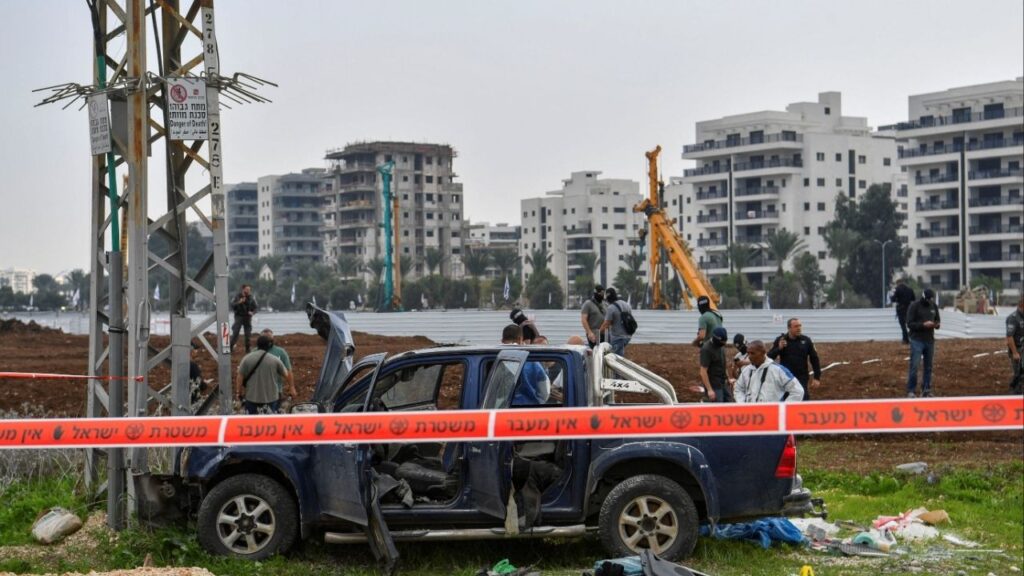An undated image courtesy of Conflict Armament Research that is said to show remnants of a motor used to guide a North Korean Hwasong-11 short-range ballistic missile that was used in an attack on Ukraine. North Korea has continued to supply advanced short-range ballistic missiles to Russia in defiance of sanctions, according to a report by a weapons research group. (courtesy of Conflict Armament Research via The New York Times)

- North Korea continues violating sanctions by supplying advanced Hwasong-11 missiles to Russia, with recent findings in Ukraine confirming their use.
- Conflict Armament Research identified Hwasong-11 missiles used in recent Kyiv attacks, showing recent production and transfer, despite long-standing sanctions.
- The U.S. and allies, including Ukraine, face challenges defending against North Korean missiles due to their advanced capabilities and rapid deployment.
Share
|
Getting your Trinity Audio player ready...
|
WASHINGTON — North Korea has continued to supply advanced short-range ballistic missiles to Russia in defiance of sanctions meant to prevent Pyongyang from developing such weapons and Moscow from importing them, according to a report by a weapons research group.
Remnants of four of the missiles, which are called Hwasong-11, were examined in Kyiv, Ukraine, on Sept. 3 by investigators from Conflict Armament Research, an independent group based in Britain that identifies and tracks weapons and ammunition used in wars around the world.
Related Story: Top US and UK Diplomats Visit Kyiv as Ukraine Pleads for Permission to Strike ...
Team Decoded Production Markings
That team decoded production markings on several parts from each missile collected by Ukrainian authorities.
A Hwasong-11 missile used in an Aug. 18 attack on Kyiv had markings showing that it was made this year. Internal parts from three others, which were used in attacks in July and August, lacked markings that would indicate when they were manufactured.
The researchers released those findings in a report Wednesday.
In early January, the White House accused North Korea of providing ballistic missiles to Russia, but subsequent shipments had not been previously reported.
The Hwasong-11 missile has a range of about 430 miles and can be fitted with nuclear or conventional warheads, according to a U.S. Army report. The missile is visually similar to the Russian Iskander short-range ballistic missile and may have been made with foreign assistance, according to the Center for Strategic and International Studies, a Washington think tank.
“The determination of the production year that we were able to make in the field by looking at those remnants shows a very tight window between production, transfer and use,” Damien Spleeters, who leads Conflict Armament Research’s operations in Ukraine, said in an interview. “And I think that’s quite significant because we are talking about North Korea, a country that has been under sanction for almost two decades.”
Related Story: US and Britain Accuse Iran of Sending Russia Missiles to Use in Ukraine
“It also shows, because this is at least a second shipment, continued violation of the sanctions because they continue to produce those missiles, to transfer them and then those missiles being used in Ukraine,” he said.
“It wasn’t a one-off in January,” Spleeters added.
Russia Used Veto Power in U.N. in March
In March, Russia used its veto power on the U.N. Security Council to end monitoring of North Korea’s efforts to evade sanctions on its nuclear program. The termination of monitors, Spleeters said, was a major reason the country has been able to continue building and transferring ordnance to Russia.
Weapons like the Russian Iskander and the North Korean Hwasong, which are fired from truck-based mobile launchers, are difficult to defend against because they fly much faster than other incoming threats like cruise missiles and can maneuver just before impact.
The United States and its allies have provided Patriot air defense systems to Ukraine to help the country fend off Russian attacks. But President Volodymyr Zelenskyy of Ukraine has said he needs more.
“Ukraine has limited air defense options to shoot down ballistic missiles like the Hwasong, and Patriots are the key weapon system for that,” Rob Lee, a senior fellow at the Foreign Policy Research Institute, said in an interview. “They only have a limited number of Patriot batteries and missiles, so Ukraine can only defend a few key areas, and the Russians can put cities at risk as well as targets on the front lines.”
Related Story: Zelenskyy Presses US Military Leaders to Let Ukraine Strike Deeper in Russia
North Korea Is Not the Only Country Supplying Russia
North Korea is not the only country sending such weapons to Russia.
On Tuesday, Secretary of State Antony Blinken accused Iran of shipping short-range ballistic missiles to Russia for use in Ukraine. As a result, Blinken said, the Biden administration was imposing more sanctions against Iran.
In August, the investigators reported that Russian forces were launching Kh-101 cruise missiles into Ukraine sometimes just weeks or months after the weapons left the factory.
The Hwasong missiles that were examined used common commercially available electronic components made by Western nations as recently as last year that ranged from the unsophisticated to fairly advanced, Spleeters said. They were similar to the components found in many Russian weapons examined by the group months into the 2022 invasion.
The finding should not be a surprise, Spleeters said, given that Russia has also been able to build advanced weapons while under international sanctions aimed at slowing their production.
“North Korea doesn’t have a domestic semiconductor industry,” he said. “So it makes sense that they would also take advantage of the global market to get access to those components.”
“This means that we also can trace them and identify the entities responsible for their diversion,” he added.
–
This article originally appeared in The New York Times.
By John Ismay
c. 2024 The New York Times Company
RELATED TOPICS:
Categories

Merced County Crash Prompts CHP Warning About Fatigued Driving

Two Dead in Palestinian Attack in Israel, Israeli Authorities Say

















